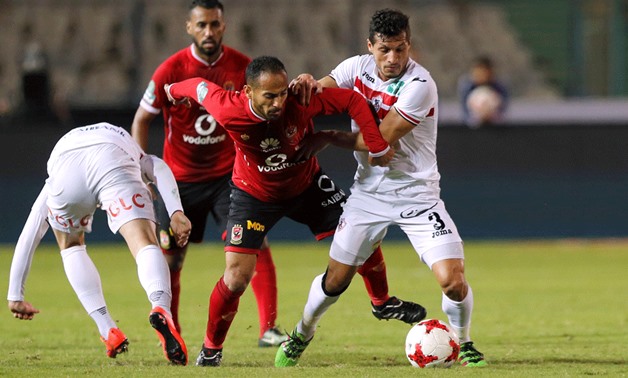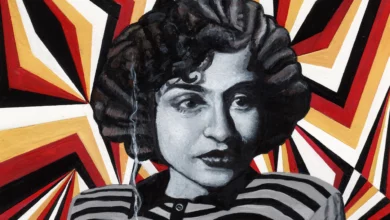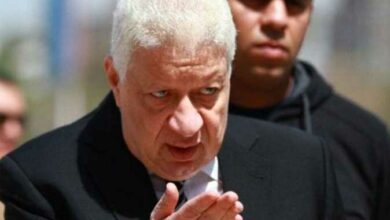Photojournalism is a tricky medium, ostensibly presenting fact while pushing the agenda of a particular publication. Opposing newspapers, by publishing vastly different photos from the same event, skew our perception of reality and shape opinion. In his explosive paintings—on display now at Zamalek’s Al Masar Gallery—Egyptian artist Hamdi Attia reinterprets photos from the news, unraveling the aesthetic of the mass media.
In Re-Presentation: Photojournalism’s Abstracting Identities Attia reproduces photographs in ink, acrylic, collage, and lettering, focusing on both posed portraits and action shots, combining elements from a war zone to a football match.
A series of faceless portraits elicit curiosity or perhaps even dissatisfaction. Who are the subjects? What about them do Attia’s colors and shapes imply that their features did not?
The solo exhibit’s iconic piece is a large canvas showing off a number of black and bronze aid parachutes floating through a blue sky. This painting uses military colors to reflect upon the boastful and dramatic efforts of the military culture.
In his Chicago studio last year, Attia invited students to analyze samples of headline-making photos, both printed and electronic, breaking down their visual components and revealing the entrenched layers of messages. “We looked beyond the matter of taste, and tried to discern the political agenda behind the image,” said Attia to Al-Masry Al-Youm.
Attia is an expert at identifying the source agency of a news photograph. “Each network has a unique prevalent style, both in the aesthetic and conceptual sense,” said Attia.
On the surface, abstract art and photojournalism are two forms with opposite purpose. While photojournalism depicts reality in context, abstract art creates its own visual language, reevaluating form, color, and line, rendering a composition that deviates from accepted truth. But Attia sees an overlap between the two disciplines.
Wielding expensive, high-tech cameras, photojournalists take hundreds of photos of the same scene. The photo chosen from these hundreds, whether by the photographer or the editor, is the angle through which an entire population views an event. But it is in this wealth of discarded photos where Attia sees art, an abstraction of real events as seen through the rapid shutter of a photojournalist and what they do and do not focus on.
“Photojournalists take hundreds of photographs while on site in Haiti, Pakistan, Gaza, or any other media-grabbing location,” said Attia. “Only ten of them serve the purpose of documenting the news–the rest represent exploration.”
Sometimes photojournalists highlight small points in a large scene and sometimes the opposite; occasionally they miss the point altogether. “Journalists forget that something like an oil spill is a disaster. They focus on the composition, the abstract perspective they hope to infuse, and this is where art and photojournalism intertwine,” said Attia.
“The journalist goes on a journey of exploration with his camera, and the purpose goes beyond coverage to deconstruction.”
Many of Attia’s paintings are accompanied by text, much like the work of a photojournalist. Oil rigs, cityscapes, wounded soldiers, and human faces—in varying degrees of abstraction—are taken out of their natural context with a spirited distribution of color. The phrases stenciled across the canvases—“The British Are Coming,” “Paid for by the Romanticized View of Simple Thoughts”—are headlines put through the same process of deconstruction as the paintings themselves.
The exhibition will run through 11 November




